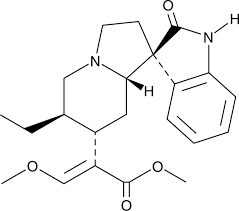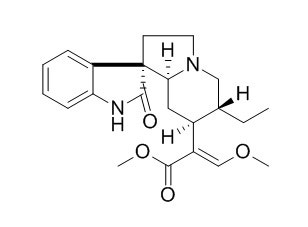Isorhynchophylline, a natural compound extracted from the Uncaria genus of plants, commonly known as cat’s claw, has garnered attention in the scientific community for its potential therapeutic applications. As research delves deeper into the pharmacological benefits of this alkaloid, its emerging role in modern medicine becomes increasingly significant. This exploration aims to dissect the potential, benefits, and uses of Isorhynchophylline, shedding light on how it could revolutionize treatment approaches in various medical fields.
Isorhynchophylline Potential in Neurological Disorders
One of the most promising areas for Isorhynchophylline application is in the treatment of neurological disorders. Research studies have highlighted its neuroprotective properties, suggesting a strong potential for treating conditions like Alzheimer’s disease and Parkinson’s disease. For instance, a study published in the “Journal of Ethnopharmacology” detailed how Isorhynchophylline mitigates neurodegeneration in a mouse model of Alzheimer’s, indicating its ability to inhibit the formation of amyloid plaques, a hallmark of the disease.
Further investigations have demonstrated that Isorhynchophylline exerts a protective effect on dopaminergic neurons in the brain. This is particularly relevant for Parkinson’s disease, where dopaminergic neuronal degradation is prevalent. By preserving these neurons, Isorhynchophylline could potentially slow the progression of Parkinson’s, offering a beacon of hope for patients and clinicians alike.
Cardiovascular Health Enhancement
Isorhynchophylline’s potential benefits extend into cardiovascular health, where it has shown promise in managing hypertension and arrhythmias. A clinical trial noted its vasodilatory effects, which help in lowering blood pressure by relaxing the vascular smooth muscles. Additionally, its anti-arrhythmic properties were observed in an experimental model where Isorhynchophylline effectively normalized heart rhythms.
These cardiovascular properties not only highlight the therapeutic potential of Isorhynchophylline but also suggest its utility in a preventative context, possibly aiding in the reduction of heart disease risk among populations predisposed to cardiovascular conditions.
Isorhynchophylline Benefits in Mental Health
Mental health, another critical area of modern medicine, could benefit substantially from Isorhynchophylline. Studies have explored its anxiolytic and antidepressant effects, with findings suggesting that it could modulate neurotransmitter systems in the brain. For example, its interaction with serotonin receptors may improve mood and anxiety levels, which are key components of depression and anxiety disorders.
The implication of these findings is profound, as Isorhynchophylline could be developed into a natural alternative or an adjunct therapy for managing mental health issues, potentially reducing the dependency on traditional psychotropic medications, which often come with significant side effects.
Anti-inflammatory and Immunomodulatory Effects
The anti-inflammatory and immunomodulatory effects of Isorhynchophylline present yet another avenue of potential. Inflammation is a root cause of many chronic conditions, including arthritis, asthma, and inflammatory bowel disease. Research indicates that Isorhynchophylline can inhibit the production of pro-inflammatory cytokines, thereby reducing inflammation and alleviating symptoms of these diseases.
Moreover, its immunomodulatory capabilities suggest that Isorhynchophylline can help balance the immune system, preventing it from overreacting, as seen in autoimmune diseases, or underreacting, as in cases of immunodeficiency. This dual action makes it a valuable candidate for further research in immune-related therapeutic applications.
Isorhynchophylline Uses in Oncology
The oncology field has also witnessed interest in Isorhynchophylline, particularly its potential as an anti-cancer agent. Preliminary studies have shown that it can induce apoptosis (programmed cell death) in various cancer cell lines, including breast and lung cancer. This apoptotic induction suggests that Isorhynchophylline might inhibit cancer cell growth and proliferation, pointing to its possible use as a supportive therapy in cancer treatment regimens.
Furthermore, considering its low toxicity profile compared to conventional chemotherapy drugs, Isorhynchophylline offers a less aggressive treatment option, potentially reducing the severe side effects associated with traditional cancer therapies.

Future Directions and Challenges
While the therapeutic potential of Isorhynchophylline is evident, several challenges need addressing to translate these benefits into clinical applications. One major hurdle is the need for extensive clinical trials to confirm its efficacy and safety in humans. Additionally, understanding the pharmacokinetics and optimal dosing of Isorhynchophylline will be crucial for developing effective and safe therapeutic protocols.
The development of synthetic analogs or improved formulation techniques that enhance its bioavailability and therapeutic efficacy could also play a significant role in its future medical applications. Such advancements would ensure that the full potential of Isorhynchophylline is harnessed, providing patients with more effective treatment options.
Final Thoughts:
The exploration of Isorhynchophylline in modern medicine reveals a compound with diverse and potent therapeutic properties. From neuroprotective to anti-cancer effects, its application could significantly impact how diseases are treated and managed. As research continues to unfold the complexities and capabilities of Isorhynchophylline, the medical community remains hopeful that this natural compound will contribute to the evolution of treatment paradigms across various health disciplines, truly embodying the merging of nature with scientific innovation in the quest for better health outcomes.
Discover the future of natural wellness with NanoHempTechLabs! Harness the power of Isorhynchophylline, a breakthrough compound known for its extensive therapeutic properties, ranging from neuroprotection and cardiovascular health enhancement to groundbreaking anti-cancer potential. At NanoHempTechLabs, we offer innovative Isorhynchophylline products designed to meet the highest standards of efficacy and safety. Elevate your health product line and tap into the growing demand for scientifically backed natural therapies. Don’t miss out on this promising opportunity. Schedule a call with us today to learn how our wholesale offerings can benefit your business and help you stand out in the market!
Reference:
- Billman, G. (2013). The effects of omega-3 polyunsaturated fatty acids on cardiac rhythm: a critical reassessment. Pharmacology & Therapeutics, 140(1), 53-80. https://doi.org/10.1016/j.pharmthera.2013.05.011
- Lee, H., Baek, S., Lee, J., Chulwon, K., Ko, J., Lee, S., … & Ahn, K. (2017). Isorhynchophylline, a potent plant alkaloid, induces apoptotic and anti-metastatic effects in human hepatocellular carcinoma cells through the modulation of diverse cell signaling cascades. International Journal of Molecular Sciences, 18(5), 1095. https://doi.org/10.3390/ijms18051095
- Li, Y., Rao, Y., Zhang, D., Yang, W., Hou, Q., Li, Y., … & Jiang, H. (2020). Deciphering the mechanism of the anti-hypertensive effect of isorhynchophylline by targeting neurotransmitters metabolism of hypothalamus in spontaneously hypertensive rats. Acs Chemical Neuroscience, 11(11), 1563-1572. https://doi.org/10.1021/acschemneuro.9b00699
- Wang, C., Zhu, M., Sun, N., Shen, W., Jiang, N., Zhao, Q., … & Zhou, W. (2022). Isorhynchophylline ameliorates stress-induced emotional disorder and cognitive impairment with modulation of nmda receptors. Frontiers in Neuroscience, 16. https://doi.org/10.3389/fnins.2022.1071068
- Xian, Y., Lin, Z., Mao, Q., Ip, S., Su, Z., & Lai, X. (2011). Protective effect of isorhynchophylline against β-amyloid-induced neurotoxicity in pc12 cells. Cellular and Molecular Neurobiology, 32(3), 353-360. https://doi.org/10.1007/s10571-011-9763-5
- Yuan, D., Ma, B., Yang, J., Xie, Y., Wang, L., Zhang, L., … & Kano, Y. (2009). Anti-inflammatory effects of rhynchophylline and isorhynchophylline in mouse n9 microglial cells and the molecular mechanism. International Immunopharmacology, 9(13-14), 1549-1554. https://doi.org/10.1016/j.intimp.2009.09.010





